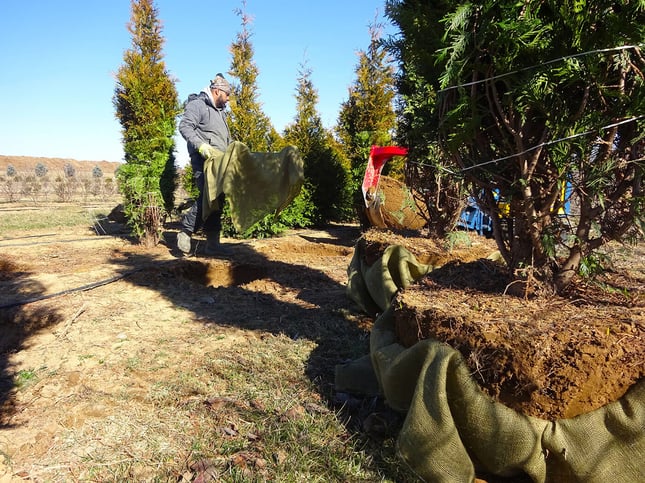Is there a connection between root ball size and the quality of the landscape trees and shrubs it supports? We say yes.
Ideally, every landscape plant you purchase is perfectly healthy, happy, and ready to be transplanted without any problems. In fact, many of our customers tell us that they keep coming back to Waverly Farm because, “Your plants do well. We don’t have to worry about them!”
That’s a great compliment, but it takes a lot of work to get to that point, and that work starts with the root system. After all, the root system is a total support mechanism. A landscape plant cannot look robust and healthy above ground without a healthy, well-developed root system to feed it.
So, how do we develop a healthy root system in the field and how large a root ball should we take at the time we harvest our landscape trees and shrubs?
Is Bigger Better? Industry Standards for Root Ball Size
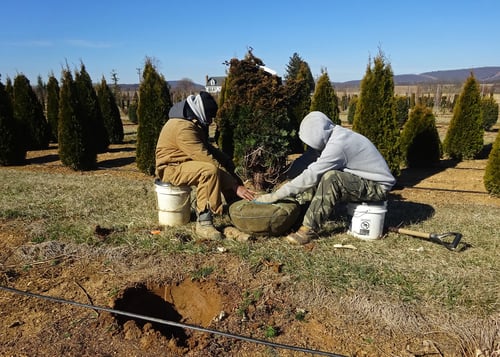 There is an extensive set of standards developed by the National Bureau of Standards (NIST) in collaboration with industry experts to describe every type of field plant by height and by caliper. The entire document is around 70 pages, has been around for decades, and was updated in 2004. It covers everything from the minimum root ball size for an upright narrow conifer to the specific caliper measurement based on the diameter of the trunk six inches above the ground.
There is an extensive set of standards developed by the National Bureau of Standards (NIST) in collaboration with industry experts to describe every type of field plant by height and by caliper. The entire document is around 70 pages, has been around for decades, and was updated in 2004. It covers everything from the minimum root ball size for an upright narrow conifer to the specific caliper measurement based on the diameter of the trunk six inches above the ground.
The NIST standards apply ball size requirements to every species and genus of landscape trees and shrubs based on the type of root system:
- Coarse root systems require a larger ball to gather more root mass.
- Fine root systems can do well with a smaller ball.
If you’re looking for a starting point, know that the industry standard for most trees is 10 inches of ball diameter per one inch of caliper. So, a three-inch caliper tree would require a minimum 30-inch diameter ball. It is our opinion that the measurement should be approximately 12 inches per caliper inch.
At Waverly Farm, we almost always dig a larger ball than required because it gives our trees and shrubs a longer shelf life in the holding yards, and makes for a happier and healthier plant. This is what we’ve learned over the years.
Promoting Vigorous Root Development in the Field
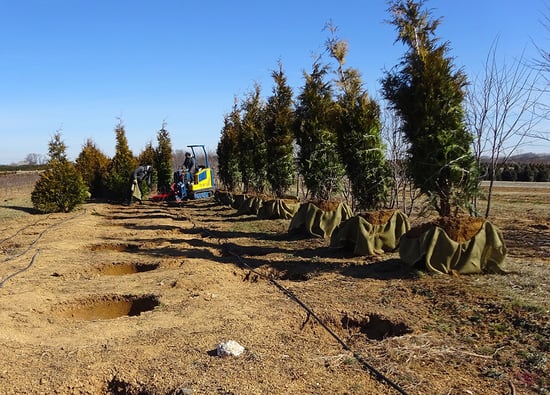 But is the size of your root ball what makes all the difference? Not exactly. Bigger is better, but not simply because of size. Increased size is the result of capturing an expansive, robust root system in the rootball. The ball is larger because it contains more of the good stuff—and that’s why it’s better.
But is the size of your root ball what makes all the difference? Not exactly. Bigger is better, but not simply because of size. Increased size is the result of capturing an expansive, robust root system in the rootball. The ball is larger because it contains more of the good stuff—and that’s why it’s better.
We discovered that prolific root development came as one of the benefits of employing drip irrigation in our rows. When used appropriately, a drip system is a tremendous aid to stimulating compact root systems. Since roots tend to go where water is, a drip system ensures that feeder roots near the surface spread laterally and grow densely to capture all the moisture coming to them through the system. It's also extremely important to know how much and when to water. Too much water squeezes the oxygen out......another story for the future.
And all of this brings us to an important point about size: the bigger root ball we are describing here comes from increased width not depth.
Capturing All the Good Stuff: Harvesting Landscape Trees & Shrubs
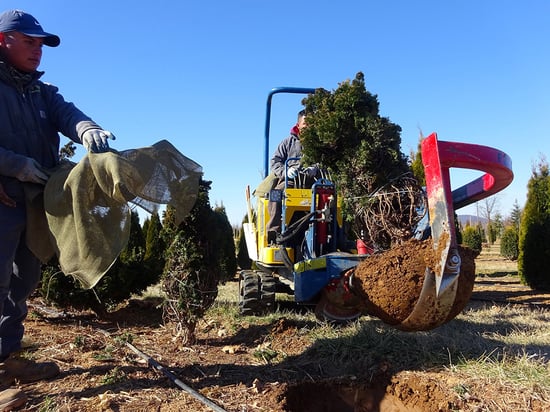 The larger root ball is a wider root ball that captures feeder roots that develop outward from the trunk. To facilitate capturing this enhanced root system, we invested in European harvesting equipment that allows us to capture a wider ball. When we dig we go wide but not deep to capture the main root mass which is closer to the surface.
The larger root ball is a wider root ball that captures feeder roots that develop outward from the trunk. To facilitate capturing this enhanced root system, we invested in European harvesting equipment that allows us to capture a wider ball. When we dig we go wide but not deep to capture the main root mass which is closer to the surface.
Key benefits of this harvesting method are:
- The wider root ball captures more productive feeder roots, more nutrient rich soil, less unproductive subsurface soil
- The decreased depth eliminates the excess weight of soil without roots.
- The oval root ball shape provides a flatter bottom that allows for easier handling, a stand up plant and ball, and more shallow excavation at planting.
These characteristics get our landscape trees and shrubs off to a strong start in life and give them extra vigor that sustains them through the stressful shipping and transplanting phase of their life.
A Gift That Keeps on Giving
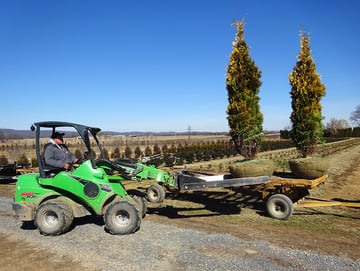 Because every step in our growing operation is aimed at producing high value plant material, we see no upside to leaving valuable feeder roots behind when we dig. We think all that value should be packaged up and sent off with our landscape trees and shrubs wherever they go. It’s best for the long-term success of the plant–which means it’s best for the success of your landscape design.
Because every step in our growing operation is aimed at producing high value plant material, we see no upside to leaving valuable feeder roots behind when we dig. We think all that value should be packaged up and sent off with our landscape trees and shrubs wherever they go. It’s best for the long-term success of the plant–which means it’s best for the success of your landscape design.
That vibrant, healthy root system balled and burlapped up into that root ball is the gift that keeps on giving long after that tree or shrub has been shipped off to its new home in somebody’s backyard. With that hefty root ball, a splendid Cornus or picture perfect Hibiscus takes a healthy chunk of its familiar home territory to its new home.
We all stand to benefit from high value plant material sold at prices that honestly account for what it takes to produce that value. But how do we know we are purchasing the best plant material for the best price?
Our ebook “Why Accurate Plant Pricing is Good for Everyone” will give you a fresh perspective on the delicate balance between price and value.




